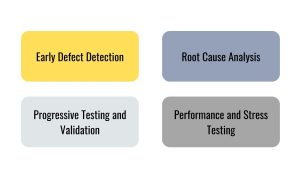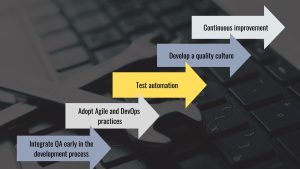QA in Ensuring Product Reliability
Introduction In today’s competitive business environment, ensuring product reliability and customer satisfaction is of utmost importance. One of the key elements in achieving ...

Introduction
In today’s competitive business environment, ensuring product reliability and customer satisfaction is of utmost importance. One of the key elements in achieving these goals is a robust quality assurance (QA) process. QA is not just a step in the product development life cycle; it is a critical component that permeates every phase, ensuring that the final product meets or exceeds customer expectations. This article examines how QA contributes to product reliability and customer satisfaction, and discusses the various aspects and importance of this process.
Understanding Quality Assurance (QA)
Quality assurance is a systematic process designed to determine whether a product or service meets specified requirements. It includes a series of planned and systematic activities implemented in a quality system to ensure that the quality requirements of a product or service are met. Quality assurance is proactive and preventive, aimed at improving the development and testing processes so that defects do not occur during product development.
QA and Product Reliability
Product reliability refers to the consistency of a product’s performance over time. Reliable products perform their intended functions under specified conditions for a specified period without failure. Here’s how QA improves product reliability.

- Early Defect Detection
One of the primary goals of QA is to detect defects early. By implementing QA processes early in the product development lifecycle, potential issues can be identified and addressed before they develop into more serious problems. This proactive approach helps maintain product reliability.
- Progressive Testing and Validation
QA involves rigorous testing and validation of the product at various stages of development. This includes unit testing, integration testing, system testing, and acceptance testing. Progressive testing ensures that the product functions correctly in various scenarios and meets the required specifications, thereby increasing its reliability.
- Root Cause Analysis
QA teams often conduct root cause analysis to determine the root causes of defects. By understanding why defects occur, teams can implement changes to prevent them in the future, resulting in more reliable products.
- Performance and Stress Testing
Performance testing evaluates the behaviour of a product under various conditions, including peak loads and stress scenarios. By ensuring that the product can handle these situations without failure, QA contributes to its overall reliability.
QA and Customer Satisfaction
Customer satisfaction is a measure of how well products or services meet or exceed customer expectations. High levels of customer satisfaction lead to customer loyalty, repeat business, and positive reviews. Here’s how QA contributes to customer satisfaction:
- Product Quality Assurance
At its core, QA ensures that the product meets the quality standards expected by customers. A high-quality product that performs as expected leads to customer satisfaction.
- Consistency in Delivery
QA ensures that every product released meets the same high standards. Consistency in product quality builds trust and confidence among customers because they know they can rely on the product to meet their needs.
- User Experience
QA includes usability testing, which evaluates the product’s user interface and overall user experience. A product that is easy to use and meets user expectations in terms of functionality and performance is more likely to satisfy customers.
- Timely Issue Resolution
QA teams also play an important role in post-release support. By quickly identifying and resolving issues reported by customers, QA ensures that any disruptions to the customer experience are minimised, leading to higher levels of satisfaction.
- Standards Compliance
QA ensures that products comply with industry standards and regulations. Compliance not only avoids legal issues, but also assures customers that products are safe and reliable.
Implementing Effective QA Practices
To maximise the benefits of QA in terms of product reliability and customer satisfaction, organisations need to implement effective QA practices. Here are some best practices.

- Integrate QA early in the development process
QA should be involved from the initial stages of product development. Early integration ensures that quality is built into the product from the beginning, rather than being tested at the end.
- Adopt Agile and DevOps practices
Agile and DevOps practices emphasise continuous integration and continuous testing. By implementing these methodologies, organisations can ensure that QA is a continuous process, resulting in higher quality products.
- Test automation
Automated testing tools can perform repetitive and complex tests more efficiently than manual testing. Automation helps identify defects quickly and reduces the time required for testing, allowing for faster releases without compromising quality.
- Develop a quality culture
Quality should be a shared responsibility across the entire organisation. By developing a culture that values quality, organisations can ensure that every team member is committed to delivering high-quality products.
- Continuous improvement
QA is not a one-time event, but an ongoing process. Organisations should regularly review and improve their quality assurance processes based on feedback and lessons learned from previous projects.
Conclusion
Quality assurance is a vital element in ensuring product reliability and customer satisfaction. By implementing robust quality assurance processes, organisations can detect defects early, ensure consistent product performance, and deliver high-quality products that meet customer expectations. Ultimately, effective quality assurance results in reliable products, customer satisfaction, and a strong competitive advantage in the marketplace.